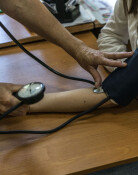Two-fifths of emergency medical centers face risk of collapse of medical care
Two-fifths of emergency medical centers face risk of collapse of medical care
Posted September. 05, 2024 07:55,
Updated September. 05, 2024 07:55
It was found by the Ministry of Health and Welfare that 18 out of 44 regional emergency medical centers (41 percent) are on the verge of halting their emergency rooms, which suffer from shortages of specialists. Severe and emergency patients in a region are sent and treated ultimately at their regional emergency medical center. Even these facilities are likely to suffer operational disruption because they cannot afford to provide a working environment where two specialists work shifts every day.
Obviously, they have had a more challenging time keeping emergency rooms up and running since the expansion of medical school places caused residents and specialists to leave hospitals. However, it may come as no surprise that emergency rooms have chronic labor shortages. Things are only getting worse as many emergency patients in search of any ER available in the vicinity have ended up at regional emergency medical centers. Hanyang University Medical Center, the only regional emergency medical center in the southeast area of Seoul, barely treats severe patients, with only 11 doctors currently on duty - although it had 20 doctors previously. Ewha Womans University Mokdong Hospital, in charge of the southeast region of Seoul, has decided to halt late-night service on Wednesdays. Likewise, Ajou University Hospital, responsible for the southwestern region of Gyeonggi Province, provides emergency care exclusively to patients with cardiac arrest every Thursday.
The government figured out that five out of 406 ERs across the country have shut down partially or intend to do so, announcing a plan to dispatch 15 army surgeons. However, it only seems like a quick fix given that a growing number of ERs are open but incapable of treating patients. Since resident doctors started quitting their jobs collectively in February, the 119 Emergency Situation Control Center has received 1,197 cases asking for any available medical center nearby. The number of such calls more than doubled compared to the same period last year.
Despite such nationwide urgency, a presidential office insider merely stated that army surgeons and public health doctors are allocated to fill the gaps in residency posts, protesting that it is a downright lie that emergency rooms are collapsing, thereby taking down the national medical system. With the presidential office having such a low awareness of what the realities are like, some voices from the ruling party even say, “It seems that the sense of urgency that citizens feel at the forefront is not shared with the presidential office or the administration given their explanations,” even questioning that the president may get wrongly briefed on the situation.
Fundamental solutions remain elusive as the government carelessly assumes that the country’s ER staffing crunch all comes down to the medical community’s collective opposition to the medical reform and a lack of cooperation from the media while only coming up with makeshift measures such as the dispatch of army surgeons. The government, in effect, failed to respond properly, only proving irresponsible in helping patients desperately seek beds in ERs for the past seven months.







